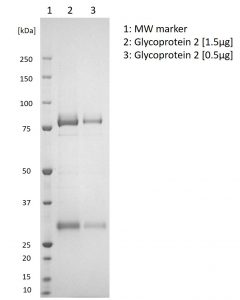SDS-PAGE showing purified recombinant glycoprotein 2.
Puumala Virus Glycoprotein 2 (Gc), Human Heterodimeric Fc-tag
Recombinant Puumala virus glycoprotein G2 (Gc) is manufactured in HEK293 cells with C-terminal human heterodimeric Fc-tag.
PUUMALA VIRUS GLYCOPROTEIN 2 (GC), HUMAN HETERODIMERIC FC-TAG
Recombinant Puumala virus glycoprotein 2 (Gc), corresponding to amino acids 660-1116 of the M segment polyprotein of PUUV, contains a C-terminal human IgG1 Fc-tag with a 15 AA glycine-serine linker. The fusion protein was co-expressed with the corresponding unloaded human IgG1 Fc chain.
PRODUCT DETAILS – PUUMALA VIRUS GLYCOPROTEIN 2 (GC), HUMAN HETERODIMERIC FC-TAG
- Puumala Virus Glycoprotein 2 (Gn), amino acids 660-1116 (strain Umea/hu, NCBI Accession Number: AAS19473.1).
- Includes a C-terminal human IgG1 Fc-tag.
- Produced in HEK293 expression system and buffered in DPBS pH7.4.
- Greater than 90% purity by SDS-PAGE.
BACKGROUND
Puumala virus (PUUV) is an enveloped, single-stranded negative-sense RNA virus. PUUV is a Hantavirus that belongs to the Hantavirus genus, within the family Bunyaviridae. Hantaviruses are zoonotic pathogens that have global distribution. Rodents and small mammals act as natural reservoirs for Hantaviruses, with each Hantavirus strain being transmitted by a different rodent host species or related species.
The hantavirus virion comprises three genome segments S, M and L, that encode the nucleocapsid (N) protein, glycoprotein precursor (GPC) and RNA-dependent RNA-polymerase, respectively (Schmaljohn, 2007). GPC is a polyprotein of 1133–1158 amino acid (aa) residues in length (Spiropoulou, 2011). Cotranslational cleavage of GPC (a 1133–1158 amino acid polyprotein) at a site C-terminal to a conserved ‘WAASA’ sequence by the cellular signal peptidase complex produces glycoproteins G1/Gn and G2/Gc, respectively (Löber, et al., 2001). These glycoproteins are responsible for virus attachment and entry into the host cells and are considered to be a major determinant of virus pathogenicity (Spiropoulou, 2011).
The G1 and G2 cytoplasmic tails interact with virus encoded ribonucleoprotein (RNP) complexes and are involved in virion assembly (Schmaljohn, et al., 1985; Hepojoki, et al., 2012). They form a spike complex, which is located on the outer surface of the virion with each spike containing four molecules of both glycoproteins. Virus-membrane fusion activity has been associated with G2 through the identification of a fusion peptide which appears to be conserved across the Bunyaviridae (Battisti, et al., 2011). Chimeric VLPs have been described for the generation of virus-reactive mAbs against hantavirus G2 glycoprotein (Zvirbliene, et al., 2014) which will be a useful tool for the development of diagnostic assays.
REFERENCES
- Battisti, A. J., Chu, Y. K. & et al., 2011. Structural studies of Hantaan virus. J Virol., 85(2), pp. 835-41.
- Hepojoki, J., Strandin, T. & et al., 2012. Hantavirus structure–molecular interactions behind the scene. J Gen Virol., 93(8), pp. 1631-44.
- Löber, C., Anheier, B. & et al., 2001. The Hantaan virus glycoprotein precursor is cleaved at the conserved pentapeptide WAASA. Virology, 289(2), pp. 224-9.
- Schmaljohn, C. S., 2007. Bunyaviridae. In: D. M. Knipe & P. M. Howley, eds. Fields Virology. Philadelphia, PA, USA: Lippencott Williams & Wilkins, p. 1741–1789.
- Schmaljohn, C. S., Hasty, S. E. & et al., 1985. Antigenic and genetic properties of viruses linked to hemorrhagic fever with renal syndrome. Science, 227(4690), pp. 1041-4.
- Spiropoulou, C. F., 2011. Bunyaviridae: Molecular and cellular biology. In: A. Plyusnin, R. Elliott & M. Norfolk, eds. Molecular Biology of Hantavirus Infection. Norfolk, UK: Caister Academic Press, p. 41–60.
- Zvirbliene, A., Kucinskaite-Kodze, I. & et al., 2014. The Use of Chimeric Virus-like Particles Harbouring a Segment of Hantavirus Gc Glycoprotein to Generate a Broadly-Reactive Hantavirus-Specific Monoclonal Antibody. Viruses, 6(2), p. 640–660.


